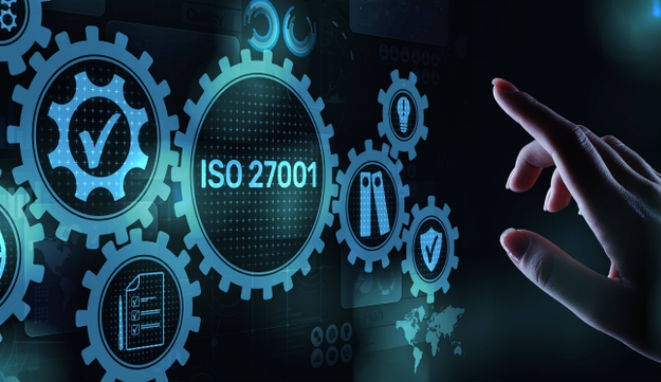In a world where 43% of cyberattacks target SMEs and the average cost of a data breach reaches £3.1 million according to IBM, cybersecurity is no longer an option but an absolute necessity. For executives, CIOs and CISOs, the question is no longer whether to invest in IT security, but how to do so effectively.
The ISO 27001 standard is now the global benchmark for cybersecurity governance. It provides a structured framework for establishing, maintaining and continuously improving an information security management system. But beyond a simple certificate, this standard is a real strategic lever for transforming cybersecurity from a cost centre into a competitive advantage.
What is the ISO 27001 standard?
Definition and fundamental principles
ISO 27001 is an international standard that defines the requirements for establishing, implementing, maintaining and improving an Information Security Management System (ISMS). Unlike purely technical approaches, this standard takes a holistic view of IT security, integrating organisational, human and technological aspects.
The central principle is based on the CIA triad: Confidentiality, Integrity and Availability of information. This approach ensures that sensitive data remains protected against unauthorised access, that it retains its accuracy and that it remains accessible to legitimate users.
Structure of the standard and Annex A
The standard consists of two main parts:
- ISMS requirements (clauses 4 to 10): define the management framework
- Annex A: lists 93 security measures organised into four thematic areas
This structure allows organisations to adapt their IT security policy to their specific context, while complying with an internationally recognised framework.
Why obtain ISO 27001 certification?
Strategic benefits for the company
ISO 27001 certification offers tangible benefits that go far beyond the technical scope:
Enhanced customer confidence: 89% of certified companies report an improvement in their brand image. This certification is becoming a decisive selling point, particularly in public and private tenders.
Easier regulatory compliance: With the entry into force of NIS2 and the strengthening of the GDPR, certification provides tangible proof of cybersecurity regulatory compliance. It greatly facilitates GDPR audits and demonstrates the implementation of robust internal security controls.
Reduced insurance costs: Insurance companies now offer discounts of up to 20% for ISO 27001-certified companies.
Impact on cyber risk management
The implementation of an ISMS transforms the approach to cyber risk management. Instead of reacting to incidents, the organisation adopts a proactive stance based on:
- Systematic identification of information assets
- Continuous assessment of threats and vulnerabilities
- Implementing appropriate preventive measures
- Monitoring security incidents and continuous improvement
This structured approach significantly reduces exposure to cyber risks while optimising security investments.
Key implementation steps
Phase 1: Cybersecurity maturity assessment
Before taking any action, a comprehensive cybersecurity audit is required. This assessment allows you to:
- Map the existing situation and identify any gaps with ISO 27001
- Assess the maturity of current security processes
- Define priorities for action based on the risks identified
- Estimate the resources required for certification
The corporate IT audit must cover the entire information system, including organisational, technical and human aspects.
Phase 2: Defining the scope and objectives
Defining the scope of certification is a crucial step. It must take into account:
- The organisation’s business strategy
- Applicable regulatory requirements
- Stakeholder expectations
- Budgetary and organisational constraints
This strategic thinking helps to optimise investment and ensure team buy-in.
Phase 3: Implementation of the ISMS
The implementation of the management system follows a structured process approach:
Governance and management: Establishment of a cybersecurity steering committee, definition of roles and responsibilities, creation of a cybersecurity dashboard for monitoring key indicators.
Policy and procedures: Drafting of the IT security policy, development of operational procedures, training and awareness-raising for employees.
Technical measures: Deployment of security controls identified during risk analysis, implementation of monitoring and detection tools, testing of security devices.
Certification audit and maintaining compliance
The external audit process
ISO 27001 certification involves an external audit carried out by an accredited body. This process takes place in two stages:
Stage 1 audit: Documentary review of the ISMS, verification of organisational maturity, identification of major non-conformities.
Stage 2 audit: Full on-site audit, testing of control effectiveness, team interviews, validation of compliance with requirements.
Preparing for these audits requires a thorough IT security review and the compilation of a complete evidence file.
Monitoring and continuous improvement
Certification is not an end in itself but the beginning of a process of continuous improvement. It involves:
- Annual surveillance audits
- Regular internal audits
- Continuous updating of risk analysis
- Adaptation to regulatory and technological developments
This improvement process is supported by regular security reporting and the implementation of a scalable cybersecurity action plan.
Integration with other standards
Synergies with GDPR and NIS2
ISO 27001 certification greatly facilitates compliance with European regulations:
GDPR convergence: ISO 27001 security measures largely cover personal data protection requirements. This synergy optimises GDPR audit compliance efforts.
NIS2 alignment: The NIS2 Directive imposes cybersecurity requirements similar to ISO 27001 for essential and important entities. Certification therefore facilitates NIS2 compliance.
Complementarity with other standards
ISO 27001 naturally complements other standards:
- ISO 22301 for business continuity planning
- ISO 27005 for specific risk management
- COBIT for global IT governance
- ITIL for IT service management
This integrated approach enables the development of consistent and effective IT governance best practices.
Return on investment
Certification offers numerous financial benefits:
- Reduction in incidents: Certified companies see a 40% drop in security incidents
- Insurance savings: 15 to 25 per cent discounts on cyber risk policies
- Commercial advantages: Easier access to markets sensitive to cybersecurity
- Operational optimisation: Improved processes and reduced IT costs
The ROI is typically between 200% and 400% over 3 years.
Future trends and developments
Impact of artificial intelligence
AI is gradually transforming the cybersecurity landscape:
- Automation of controls: Automated detection of anomalies and breaches
- Predictive analytics: Anticipation of threats based on behavioural analysis
- Process optimisation: Automation of compliance and reporting tasks
ISO 27001 is evolving to incorporate these new technologies while maintaining a governance-focused approach.
Convergence towards cyber resilience
Beyond protection, the standard is evolving towards a comprehensive cyber resilience approach that incorporates:
- Resilience to attacks
- Rapid detection and response
- The ability to maintain critical activities
- The capacity for recovery and learning
This development reinforces the importance of business continuity planning and cyber crisis management.
Conclusion
ISO 27001 certification is much more than just a label: it is a strategic investment in the sustainability of your business. In a context of increasing cyber threats and stricter regulations, this certification provides a structured framework for developing mature and effective cybersecurity.
The benefits extend far beyond security: improved brand image, easier regulatory compliance, optimised insurance costs and, above all, the development of a security culture within your organisation.
The path to certification certainly requires a significant investment of time and resources, but the return on investment is well documented. The important thing is to start with a methodical approach, relying on recognised experts and involving the entire organisation.
Ready to turn your cybersecurity into a competitive advantage? Our team of certified experts will support you throughout your ISO 27001 process, from the initial audit to certification and operational implementation. Contact us today for a personalised assessment and find out how to secure your business for the long term while optimising your security investments.

